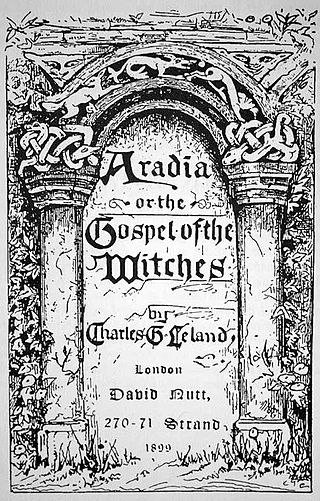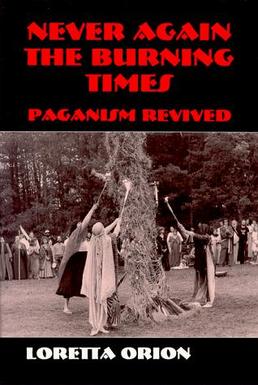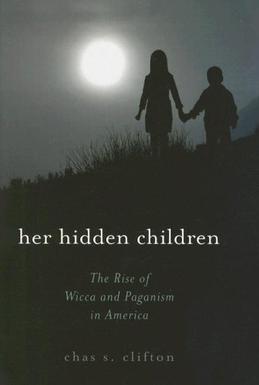Related Research Articles

Skyclad refers to ritual nudity in Wicca and Modern Paganism. Some groups, or Traditions, perform most or all of their rituals skyclad. Whilst nudity and the practice of witchcraft have long been associated in the visual arts, this contemporary ritual nudity is typically attributed to either the influence of Gerald Gardner or to a passage from Charles Godfrey Leland's 1899 book Aradia, or the Gospel of the Witches, and as such is mainly attributed to the Gardnerian and Aradian covens.
Aradia is one of the principal figures in the American folklorist Charles Godfrey Leland's 1899 work Aradia, or the Gospel of the Witches, which he believed to be a genuine religious text used by a group of pagan witches in Tuscany, a claim that has subsequently been disputed by other folklorists and historians. In Leland's Gospel, Aradia is portrayed as a messiah who was sent to Earth in order to teach the oppressed peasants how to perform witchcraft to use against the Roman Catholic Church and the upper classes.
Stregheria is a neo-pagan tradition similar to Wicca, with Italian and Italian American origins. While most practitioners consider Stregheria to be a distinct tradition from Wicca, some academics consider it to be a form of Wicca or an offshoot. Both have similar beliefs and practices. For example, Stregheria honors a pantheon centered on a Moon Goddess and a Horned God, similar to Wiccan views of divinity.
Ronald Edmund Hutton is an English historian who specialises in early modern Britain, British folklore, pre-Christian religion and Contemporary Paganism. He is a professor at the University of Bristol, has written 14 books and has appeared on British television and radio. He held a fellowship at Magdalen College, Oxford, and is a Commissioner of English Heritage.

Drawing Down the Moon: Witches, Druids, Goddess-Worshippers, and Other Pagans in America Today is a sociological study of contemporary Paganism in the United States written by the American Wiccan and journalist Margot Adler. First published in 1979 by Viking Press, it was later republished in a revised and expanded edition by Beacon Press in 1986, with third and fourth revised editions being brought out by Penguin Books in 1996 and then 2006 respectively.

Aradia, or the Gospel of the Witches is a book composed by the American folklorist Charles Godfrey Leland that was published in 1899. It contains what he believed was the religious text of a group of pagan witches in Tuscany, Italy that documented their beliefs and rituals, although various historians and folklorists have disputed the existence of such a group. In the 20th century, the book was very influential in the development of the contemporary Pagan religion of Wicca.

The Church and School of Wicca was founded by Gavin Frost and Yvonne Frost in 1968. It was the first federally recognized Church of the religion known as Wicca in the United States. It is known for its correspondence courses on the Frosts' unique interpretation of Wicca. The Church and School are located in Beckley, West Virginia.

Philip Heselton is a retired British conservation officer, a Wiccan initiate, and a writer on the subjects of Wicca, Paganism, and Earth mysteries. He is best known for two books, Wiccan Roots: Gerald Gardner and the Modern Witchcraft Revival and Gerald Gardner and the Cauldron of Inspiration, which gather historical evidence surrounding the New Forest coven and the origins of Gardnerian Wicca.

Neopagan witchcraft, sometimes referred to as The Craft, is an umbrella term for some neo-pagan traditions that include the attempted practice of magic. These traditions began in the mid-20th century and were influenced by the witch-cult hypothesis, a now-rejected theory that persecuted witches in Europe had actually been followers of a surviving pagan religion. Traditions classed as neopagan witchcraft include Wicca and the various movements that describe themselves as "Traditional Witchcraft".
The Witchcraft Research Association was a British organisation formed in 1964 in an attempt to unite and study the various claims that had emerged of surviving remnants of the so-called Witch-Cult, such as those of Gerald Gardner, Robert Cochrane, Sybil Leek, Charles Cardell and Raymond Howard.
In Modern English, the term Wicca refers to Wicca, the religion of contemporary Pagan witchcraft. It is used within the Pagan community under competing definitions. One refers to the entirety of the Pagan Witchcraft movement, while the other refers explicitly to traditions included in what is now called British Traditional Wicca.

The Triumph of the Moon: A History of Modern Pagan Witchcraft is a book of religious history by the English historian Ronald Hutton, first published by Oxford University Press in 1999. At the time, Hutton was a Reader in History at Bristol University, and had previously published a study of ancient pre-Christian religion, The Pagan Religions of the Ancient British Isles (1991) as well as studies of British folk customs and the Early Modern period.

A Community of Witches: Contemporary Neo-Paganism and Witchcraft in the United States is a sociological study of the Wiccan and wider Pagan community in the Northeastern United States. It was written by American sociologist Helen A. Berger of the West Chester University of Pennsylvania and first published in 1999 by the University of South Carolina Press. It was released as a part of a series of academic books entitled Studies in Comparative Religion, edited by Frederick M. Denny, a religious studies scholar at the University of Chicago.
Pagan studies is the multidisciplinary academic field devoted to the study of modern paganism, a broad assortment of modern religious movements, which are typically influenced by or claiming to be derived from the various pagan beliefs of premodern Europe. Pagan studies embrace a variety of different scholarly approaches to studying such religions, drawing from history, sociology, anthropology, archaeology, folkloristics, theology and other religious studies.

Enchanted Feminism: The Reclaiming Witches of San Francisco is an anthropological study of the Reclaiming Wiccan community of San Francisco. It was written by the Scandinavian theologian Jone Salomonsen of the California State University, Northridge and first published in 2002 by the Routledge.

Never Again the Burning Times: Paganism Revisited is an anthropological study of the Wiccan and wider Pagan community in the United States. It was written by the American anthropologist Loretta Orion and published by Waveland Press in 1995.

The Pomegranate: The International Journal of Pagan Studies is a peer-reviewed academic journal covering the field of Pagan studies including historical, sociological, and anthropological studies dealing with contemporary Paganism and other forms of pagan religion. Since 2004 the journal has been published by Equinox Publishing and the editor-in-chief is Chas S. Clifton.

Living Witchcraft: A Contemporary American Coven is a sociological study of an American coven of Wiccans who operated in Atlanta, Georgia during the early 1990s. It was co-written by the sociologist Allen Scarboro, psychologist Nancy Campbell and literary critic Shirley Stave and first published by Praeger in 1994. Although largely sociological, the study was interdisciplinary, and included both insider and outsider perspectives into the coven; Stave was an initiate and a practicing Wiccan while Scarboro and Campbell remained non-initiates throughout the course of their research.

Her Hidden Children: The Rise of Wicca and Paganism in America is a historical study of Wicca and Contemporary Paganism in the United States. It was written by the American academic Chas S. Clifton of Colorado State University-Pueblo, and published by AltaMira Press in 2005.

Evan John Jones (1936–2003) was an English traditional witch, occultist and writer who operated within the tradition of Cochrane's Craft.
References
Footnotes
- ↑ "The Pomegranate: The International Journal of Pagan Studies". www.equinoxjournals.com. Archived from the original on 2010-03-12. Retrieved 2008-05-26.
- ↑ "Pagan Studies / AltaMira Press". www.csulb.edu. Retrieved 2008-05-26.
- ↑ "Contemporary Pagan Studies". www.aarweb.org. Archived from the original on 2011-05-28. Retrieved 2011-05-31.
- ↑ Rabinovitch, Shelley; Lewis, James (2004). "Clifton, Chas S.". The Encyclopedia of Modern Witchcraft and Neo-Paganism. Citadel Press. pp. 48–49. ISBN 978-0-8065-2407-8.
- 1 2 3 4 5 6 7 8 9 10 11 12 Clifton and Doyle White 2012.
- 1 2 3 4 Clifton and TWPT 1999.
- ↑ Clifton 2006. p. xi.
- ↑ Clifton 2004. pp. 5–6.
Bibliography
- Clifton, Chas S. (July 1999). "TWPT Talks with Chas S. Clifton". The Wiccan/Pagan Times. Archived from the original on 27 September 2011. Retrieved 11 January 2013.
- Clifton, Chas S.; Doyle White, Ethan (27 December 2012). "An Interview with Chas S. Clifton". Albion Calling. Archived from the original on 31 December 2012. Retrieved 11 January 2013.